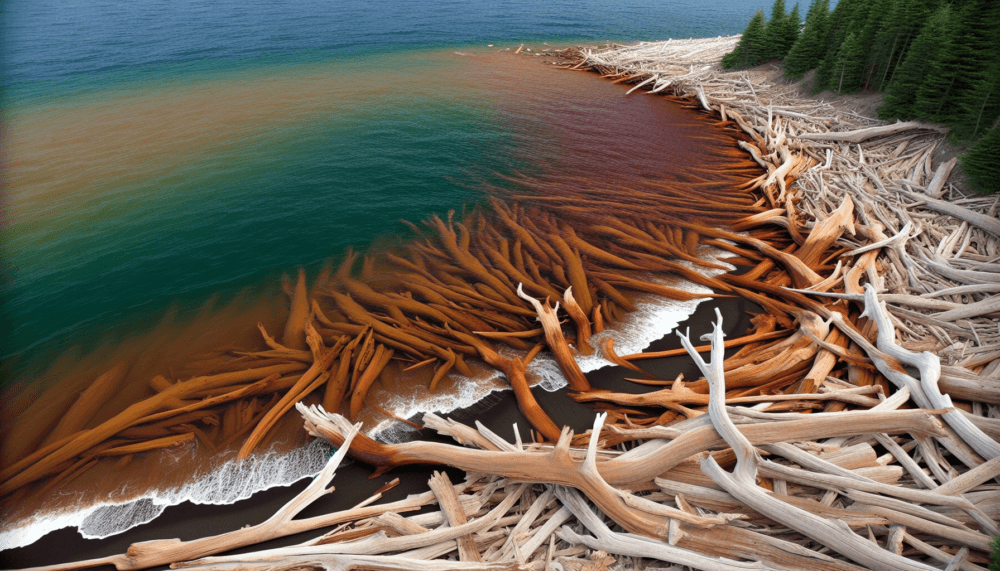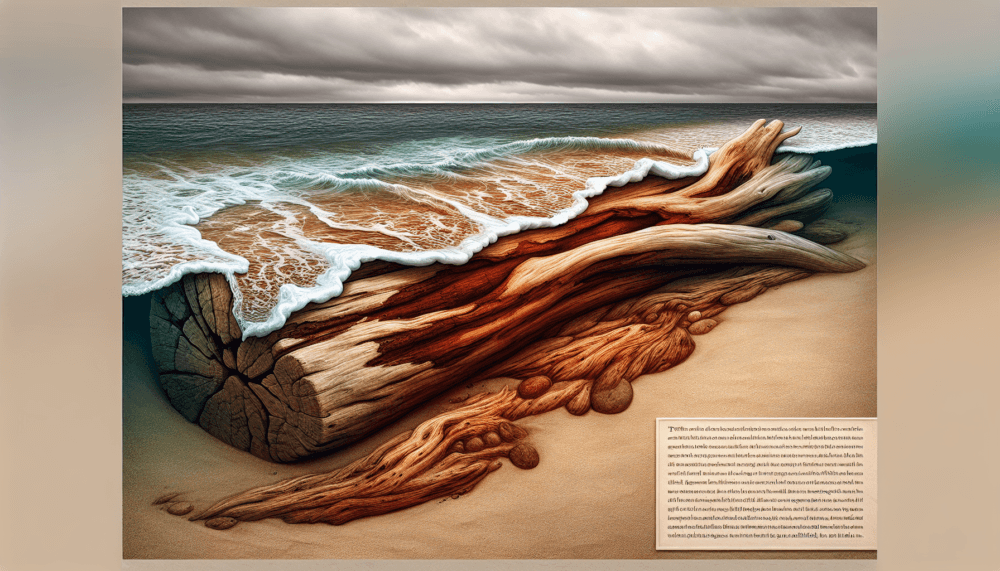Imagine standing on a beautiful, sandy beach, waves crashing in the distance, with a piece of driftwood in your hand. As you scan the shoreline, you notice the crystal-clear water gradually turning brown where the driftwood settled. But why does this happen? Can something as harmless as driftwood really be responsible for discoloring water? In this article, we will explore the fascinating phenomenon of driftwood turning water brown and unravel the reasons behind this intriguing occurrence. Prepare to be amazed as we uncover the secrets hidden beneath the surface of the ocean.

What is driftwood?
Driftwood is a term used to describe pieces of wood that have been washed up onto shorelines or riverbanks by the action of waves, tides, or currents. These pieces of wood come from a variety of sources, including fallen trees, branches, or logs that have been carried downstream by rivers or streams. Driftwood can vary in size, shape, and texture, and it often exhibits unique and weathered characteristics due to its exposure to the elements.
Definition of driftwood
Driftwood is defined as any wood that has been carried by water and deposited on a shoreline. This wood can be from any type of tree or plant, although hardwoods are more common due to their density and ability to withstand the effects of water erosion. Driftwood can be found along coastlines, lakeshores, and riverbanks, and it is often used for various purposes, such as furniture, home decor, or even as a natural material for artistic creations.
Where does driftwood come from?
Driftwood comes from a variety of sources, both natural and man-made. Natural sources of driftwood include trees or branches that have fallen into bodies of water, such as rivers, lakes, or oceans, and are carried downstream by currents or tides. These natural processes can transport the wood over long distances, eventually depositing it onto shorelines. Man-made sources of driftwood include discarded wood from construction projects or timber operations, which can also end up in water bodies and be carried by currents.
How does water turn brown?
Water can turn brown for several reasons, including both natural causes and human activities. The discoloration of water is often due to the presence of various substances or particles that can alter its appearance and clarity.
Reasons for brown water
The primary reason for water turning brown is the presence of suspended particles, such as sediment, clay, or silt. These particles can be eroded from the surrounding land, especially during heavy rainfall or flooding events, and are then carried into bodies of water. When the particles are stirred up by water movement or currents, they can cause the water to appear brown or muddy.
Natural causes of water discoloration
Natural causes of water discoloration include the presence of organic matter, such as decaying leaves or plant material, which can release tannins and lignin into the water. These organic compounds can give the water a brown or tea-like color, particularly in areas with high concentrations of vegetation. Additionally, certain types of algae blooms or bacterial growth can also contribute to water discoloration, leading to green or brown water.
Effects of water discoloration
The discoloration of water can have various effects on both aquatic ecosystems and human activities. In natural ecosystems, water discoloration caused by organic matter can influence the availability of light and nutrients for aquatic plants and organisms. It can also impact the water’s ability to support certain species, as some may require clear water conditions to thrive. For humans, brown water can affect the aesthetic appeal of water bodies, making them less desirable for recreational activities such as swimming or boating.
Impact of driftwood on water color
Driftwood can have a significant impact on the color of water, often resulting in a brownish tint. This change in color occurs due to the interaction between the wood and the water, particularly when the wood contains certain substances or compounds.
Explanation of driftwood’s impact on water color
When driftwood is submerged in water, it can release tannins and lignin compounds, which are naturally present in the wood. These compounds can dissolve in the water and give it a brown or yellowish hue, similar to the color of tea. The intensity of the water discoloration can vary depending on the type, size, age, and condition of the driftwood, as well as the duration of its exposure to the water.
Does driftwood always turn water brown?
While driftwood can often turn water brown, especially in cases where it contains high levels of tannins and lignin, it does not always result in water discoloration. The extent to which driftwood affects water color can vary depending on various factors, including the type of wood, the specific chemical composition of the wood, and the overall concentration of organic compounds present in the wood.
Factors influencing water discoloration by driftwood
Several factors can influence the degree of water discoloration caused by driftwood. These factors include the type of driftwood, size, age, and condition of the driftwood.
Type of driftwood
Different types of wood can contain varying amounts of tannins and lignin, which are responsible for the water discoloration. Hardwood species are generally more prone to leaching these compounds into the water compared to softwood species. For example, species like oak, mahogany, or teak are known to have a higher concentration of tannins, resulting in more noticeable water discoloration.
Size of the driftwood
The size of the driftwood can also play a role in water discoloration. Larger pieces of wood typically have a greater surface area, allowing more tannins and lignin to come into contact with the water. Consequently, larger driftwood pieces are more likely to result in pronounced water discoloration compared to smaller pieces.
Age of the driftwood
The age of the driftwood can impact the intensity of water discoloration. Older pieces of wood generally contain a higher concentration of tannins and lignin due to the natural aging process. As the wood decomposes and breaks down over time, the release of these compounds into the water may increase, contributing to a more significant change in water color.
Condition of the driftwood
The condition of the driftwood, including its level of decay or decomposition, can also influence water discoloration. Driftwood that is in an advanced state of decay or decomposition may release a greater amount of organic compounds into the water, resulting in a more pronounced brown color. In contrast, freshly fallen or relatively well-preserved driftwood may have a lesser impact on water color.

Chemical reactions between driftwood and water
The discoloration of water by driftwood is primarily the result of chemical reactions between the wood and the water. These reactions involve the release and dissolution of various organic compounds from the wood.
Tannins and lignin in driftwood
Tannins are natural compounds found in plants and trees, including driftwood. They are responsible for the astringent taste in tea and the brown color of some bodies of water. Lignin, on the other hand, is a complex organic polymer that provides structural support to the cells of plants and gives wood its characteristic hardness. Both tannins and lignin can dissolve in water, leading to the discoloration of the surrounding water.
Dissolution of organic compounds
When driftwood comes into contact with water, the tannins and lignin present in the wood can dissolve due to the solubility of these compounds. This process releases the organic compounds into the water, causing the water to take on a brown or tea-like color. The rate at which the compounds dissolve can depend on various factors, including the temperature of the water, the concentration of the compounds in the wood, and the overall surface area of the wood that is exposed to the water.
Oxidation processes
In addition to dissolution, oxidation processes can also contribute to the discoloration of water by driftwood. When wood is exposed to air and moisture, compounds such as tannins can undergo oxidation reactions, resulting in the formation of darker-colored compounds. These compounds can then dissolve in the water, further enhancing the brown coloration.
Other substances in driftwood affecting water color
In addition to tannins and lignin, other substances present in driftwood can also influence the color of the water, especially if they are released into the surrounding environment.
Sap and resin
Driftwood may still contain sap or resin, depending on how recently it has fallen or been washed up. These sticky substances can leach into the water and contribute to both the discoloration and the overall chemical composition of the water. Sap and resin can have different colors and chemical properties, ranging from yellow or amber to brown or even black.
Decay and decomposition
As driftwood decays and decomposes naturally, various compounds and byproducts of the decay process can enter the water. These decomposition products can include organic acids, gases, and other chemical compounds, which may interact with the water and alter its color. The presence of decayed material can further contribute to the brownish appearance of water affected by driftwood.
Interactions between driftwood and water quality
The presence of driftwood in the water can impact water quality in several ways, including changes in pH levels, alterations to nutrient content, and modifications in water clarity.
Effects on pH levels
Driftwood, particularly when it contains tannins and organic acids, can cause a decrease in pH levels when it comes into contact with water. The release and dissolution of these compounds can make the water more acidic, potentially affecting the overall pH balance of the aquatic environment. This decrease in pH can have implications for various aquatic organisms that may have specific pH requirements for survival and reproductive success.
Impact on nutrient content
The interaction between driftwood and water can also influence nutrient content. As the wood decomposes or leaches organic compounds, nutrients such as carbon, nitrogen, and phosphorus can be released into the water. These nutrients can serve as a source of food for aquatic plants and organisms, potentially leading to increased biomass or algal blooms if the nutrient levels become excessive. However, the availability and impact of the nutrients can vary depending on the specific characteristics of the driftwood and the surrounding water.
Altering water clarity
Driftwood can contribute to a decrease in water clarity due to the presence of suspended particles and dissolved organic compounds. The particles and organic matter released by the wood can scatter and absorb light, making the water appear darker or turbid. This reduced water clarity can affect the penetration of sunlight into the water column, potentially impacting the growth and photosynthesis of aquatic plants, as well as visibility for underwater activities.
Driftwood’s role in aquatic ecosystems
Driftwood plays a significant role in aquatic ecosystems and provides various benefits for both the environment and the organisms that inhabit these ecosystems.
Driftwood as a habitat
Driftwood serves as an essential habitat for a wide range of aquatic organisms. The woody debris can offer shelter, protection, and a substrate for attachment for many species, including fish, invertebrates, and microorganisms. The wood’s complex structure can create hiding places, breeding grounds, and feeding opportunities, contributing to the overall biodiversity and ecological functioning of the aquatic environment.
Importance for aquatic organisms
Many aquatic organisms rely on driftwood as a food source or for obtaining essential nutrients. Bacteria and fungi decompose the wood, breaking it down into smaller organic particles that can be consumed by detritivores and filter feeders. Additionally, some fish species, such as salmon or trout, use driftwood as spawning grounds or nursery areas, where their eggs and fry can find protection from predators.
Positive and negative ecological effects
The presence of driftwood can have both positive and negative ecological effects. On the positive side, driftwood enhances habitat complexity, provides a source of organic matter and nutrients, and promotes species diversity in aquatic ecosystems. It can also contribute to stream and riverbank stabilization by reducing erosion and sediment transport. However, excessive amounts of driftwood or large accumulations in certain areas can block water flow, create stagnant areas, or interfere with navigation and recreational activities.
Driftwood and water-related activities
Driftwood can have implications for various water-related activities, ranging from its aesthetic value in aquariums to potential risks for drinking water sources.
Aesthetic value for aquariums
Driftwood is often a sought-after material for aquarium enthusiasts due to its natural and visually appealing characteristics. The unique shapes, textures, and colors of driftwood can create a captivating and authentic underwater landscape, providing a more natural habitat for fish and other aquatic species. However, it is essential to consider the potential impact of the wood on water quality and compatibility with the specific requirements of the aquarium inhabitants.
Risks for drinking water sources
When it comes to drinking water sources, the presence of driftwood can pose certain risks. The release of organic compounds, such as tannins or decay products, into the water can affect the taste, odor, and color of the drinking water supply. While these compounds are generally not harmful to human health, they can result in aesthetic concerns or negative perceptions regarding water quality. Consequently, proper water treatment processes may be required to address potential water discoloration caused by driftwood.
Navigation and water sports
Large accumulations of driftwood in rivers, streams, or coastal areas can obstruct and impede navigation and water sports activities. The presence of floating or partially submerged driftwood can pose hazards to boaters, swimmers, or paddlers, increasing the risk of collisions or entanglement. It is crucial for water enthusiasts to be aware of potential driftwood hazards and take appropriate precautions to ensure safety.
Preventing or reducing water discoloration caused by driftwood
To prevent or reduce water discoloration caused by driftwood, several measures can be implemented, including the removal of driftwood from water sources, water treatment methods, and alternative uses for driftwood.
Removing driftwood from water sources
Regular removal of driftwood from water sources can help minimize the potential for water discoloration. This can involve manual removal by individuals or organizations responsible for managing water bodies or implementing debris cleanup programs. Removing driftwood can be challenging due to its size and weight, especially in large rivers or coastal areas. However, timely removal can help mitigate water discoloration and prevent accumulation or blockages that could impact water flow.
Water treatment methods
Water treatment processes can be employed to address water discoloration caused by driftwood. These methods can include filtration, coagulation, sedimentation, or activated carbon treatment, which can effectively remove suspended particles and organic compounds from the water. By treating the water at the source or during the drinking water treatment process, the undesirable color and taste associated with driftwood can be reduced or eliminated.
Alternative uses for driftwood
Rather than allowing driftwood to accumulate in water bodies, it can be repurposed or used beneficially. Driftwood can be collected and utilized for various purposes, such as the creation of artwork, furniture, or decorative elements. By giving driftwood a new life and purpose, its potential impact on water discoloration can be minimized, and its aesthetic value can be appreciated in a different context.
In conclusion, driftwood is a fascinating and multifaceted natural resource that can significantly impact the color and quality of water. Its interaction with water can result in water discoloration due to the release of compounds such as tannins and lignin. Factors such as the type, size, age, and condition of the driftwood can influence the degree of water discoloration. Driftwood also plays a crucial role in aquatic ecosystems, providing habitats and resources for various organisms. However, excessive accumulations of driftwood can have negative effects on water-related activities and require proper management. By understanding the factors influencing water discoloration and implementing appropriate measures, we can appreciate the beauty and importance of driftwood while maintaining the quality and clarity of our water sources.

